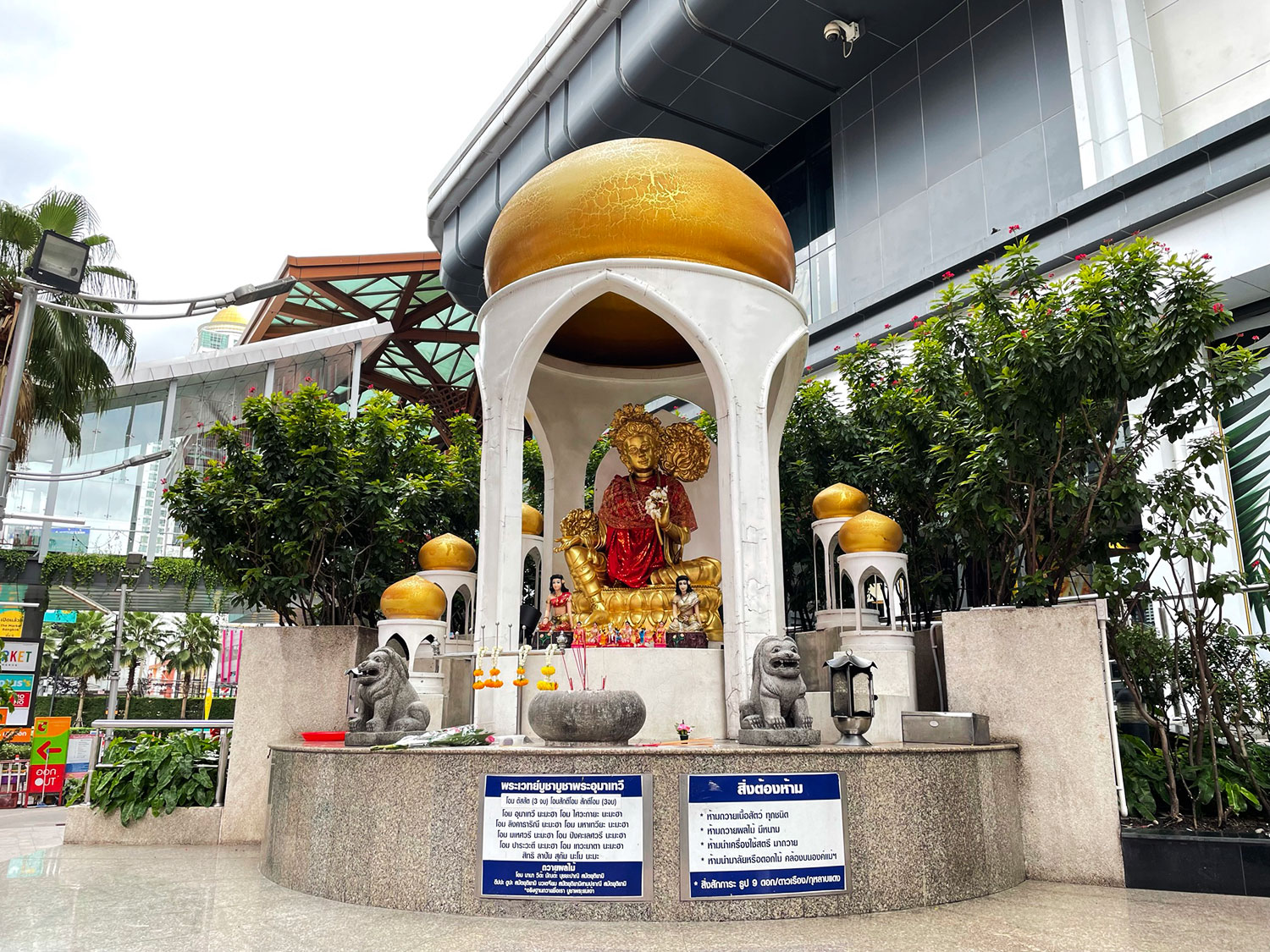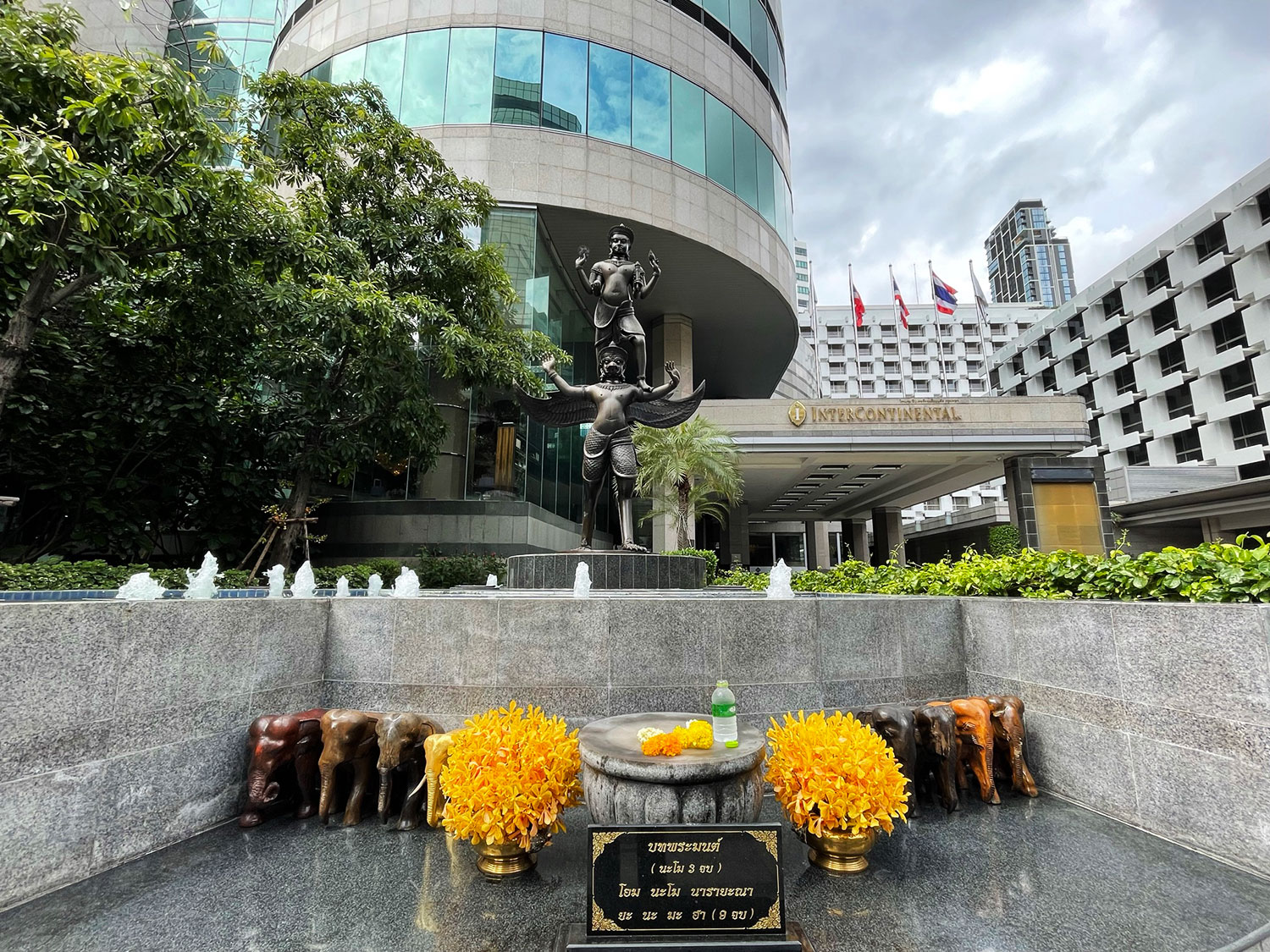With the easing of lockdown measures, Life is resuming its series of day trips along the Skytrain and MRT network after a two-month hiatus. Although museums, libraries and other recreational places are still off-limits, we'll start with a walking tour of the Ratchaprasong neighbourhood, home to sacred Hindu deities, shopping malls and a sanctuary of street food connoisseurs where you can spend the whole day.
Strolling from Chidlom BTS station, the skywalk connects to 18 major enterprises and has become a magical bridge that transports commuters back to the days when King Chulalongkorn entrusted Prince Benbadhanabongse to set up Bangkok's first mulberry plantation and sericulture school. Japanese agricultural scientist Kametaro Toyama from the University of Tokyo was put in charge of developing hybrid Thai and Japanese silk in the area.
As the commercial and residential neighbourhood grew, King Rama V later welcomed Western technology to enhance infrastructure. In 1902, he constructed the 2km Ratchadamri Road to link with Silom, Chalerm Loke Bridge and Phloenchit, whose junction was named Ratchaprasong (translated as "royal intention").
Soon after, the mulberry plantation was replaced by a string of opulent 5-star hotels and shopping malls when Bangkok became a modern metropolis, leading to Ratchaprasong intersection being turned into a major commercial centre and a popular tourist attraction.

The Indra Shrine sits at the front of Amarin Plaza. (Photo: Pattarawadee Saengmanee)

The Umathevi Shrine is situated near Big C Ratchadamri. (Photo: Pattarawadee Saengmanee)

Ratchaprasong intersection was a mulberry plantation during the reign of King Chulalongkorn before becoming the major shopping venue it is today. (Photo: Wichan Charoenkiatpakul)
Back in 1956, the Syndicate of Thai Hotels and Tourists Enterprises opened Erawan Hotel on Ratchadamri Road to serve vacationers with 250 elegant rooms and first-class hospitality services while Thai Daimaru opened its doors in 1964 on the site where Big C Ratchadamri now sits. It was recognised as the country's first department store, equipped with air conditioning and escalators and it attracted people from around town to enjoy a new shopping experience.
Influenced by Hindu beliefs, a group of entrepreneurs crafted magnificent shrines of eight Hindu deities in the hopes of bringing success, wealth and peace to their enterprises and properties.
Located in front of the Grand Hyatt Erawan Bangkok, formerly known as the Erawan Hotel, the iconic Erawan Shrine is a good place to start. It was the first to be built in the Ratchaprasong area, indicating the birth of a commerce and transportation centre.
It was said that several mishaps had occurred during the hotel's construction because the foundation-laying ceremony was held at a bad time. Luang Suwichanpat, who specialised in astrology, advised the founder to build the Erawan Shrine and spiritual house to pay respect to the local deities.
Built in 1956, it has now become one of Thailand's most famous religious destinations, drawing tourists from Singapore, Hong Kong and China to pray for good fortune.
Decked with gleaming glass, the shrine houses a gold statue of the highly-revered four-headed Brahma, the god of creation, holding symbolic items -- bread, scripture, a water jug and a lotus bloom -- to fend off evil. Apart from offering a bunch of marigold garlands and joss sticks, visitors can hire a group of performers to entertain the deities.
The shrine made headlines in 2006 when a man smashed the statue with a hammer, fracturing the bust and the body. He was badly assaulted by onlookers and later succumbed to his injuries and died.
According to reports, he appeared to be a mentally ill individual. To heal pilgrims' minds, a new statue was immediately erected to replace the original, which was sculpted by talented Fine Arts Department artist Chit Phimkowit.

The Trimurti Shrine at CentralWorld. (Photo: Pattarawadee Saengmanee)

Pilgrims present red roses to the god of love to ask for protection and romance. (Photo: Wichan Charoenkiatpakul)

Go Ang Pratunam Chicken Rice is famous for its juicy Hainanese chicken. (Photo © Go Ang Pratunam Chicken Rice)

At CentralWorld, the Ganesha Shrine stands alongside the Trimurti Shrine. (Photo: Pattarawadee Saengmanee)
Opposite, the Lakshmi Shrine has transformed an alfresco space on the 4th floor of Gaysorn Village into a haven for pilgrims to pray for prosperity and success in business negotiations.
It's home to a beautiful gold statue of the goddess of wealth and fortune standing on a lotus flower. She is a consort of the god Vishnu who helped him create and protect the universe from demons. If prayers are granted, pilgrims can return to the shrine and express their gratitude by offering some cane juice, coconut or Thai sweets to the goddess.
Situated under the same roof, the Jatulokbal Shrine houses a statue of the god of four directions who serves as a guardian to keep inhabitants safe. He's like a cross between Lord Vesuwan and Kuvera.
Next door, the InterContinental Hotel has the Narayana Shrine, home to the god of protection riding a garuda. He's an avatar of god Vishnu, whose four hands hold a rowel, conch shell, lotus and sceptre to embody the ultimate trinity and provide serenity, contentment, professional success and the ability to conquer difficulties.
Walking down from Chidlom BTS station to Amarin Plaza, you can see Indra Shrine where pilgrims pay respect to the god of thunder, who provides dawn to the Earth and can tear seas and mountains apart and restore harmony.
He is respected for sustaining goodness, expelling evil, maintaining business prosperity, and protecting those who live a virtuous life, with his four hands carrying a conch shell, sword, bow and javelin.
The tour continues to the Umathevi Shrine, which is situated near Big C Ratchadamri. She is the goddess of compassion and known for her unwavering love for her husband Shiva, the god of destruction. A statue of Umathevi is usually depicted riding a tiger and wielding a long-handled trident or sword, symbolising her tremendous might against enemies.
However, her statue in downtown Bangkok sits on a lotus and features flowers in her left hand to grant wishes and blessings to families. Flowers, fruit and incense can be used to offer devotion to the goddess.
Located in CentralWorld, those seeking their soul mate can cross the skywalk to the Trimurti Shrine and offer red roses to the god of love, a combination of the god of creation, god of protection and god of destruction.
During World War II, his statue was placed to protect Petchaboon Palace, which once stood on the present location of CentralWorld. The palace remained safe while the parts of the city were hit by devastating bombing. Many believed that it was the god of love's great power and his shrine became a popular site for pilgrims to ask for protection, good fortune and love.

Wat Pathum Wanaram Ratchaworawihan was built during the reign of King Rama IV. (Photo: Pongpet Mekloy)

The InterContinental Hotel houses the Narayana Shrine. (Photo: Pattarawadee Saengmanee)
The Trimurti Shrine shares space with the Ganesha Shrine. It houses a statue of the god of success, the son of Shiva and Umathevi, who has an elephant head as well as four hands clutching a short-handled trident, broken tusk, rope and beads that snake around his belly, representing inner power. Also recognised as a patron of the arts and education, students and artists may prepare red lotus, marigold garlands, sweets, fruits or elephant figures to ask for success in examinations and works.
Standing between CentralWorld and Siam Paragon, Wat Pathum Wanaram Ratchaworawihan is the sole remaining structure from the early Rattanakosin period. It was erected during the reign of King Rama IV and its walls covered with bas-relief images of lotus flowers.
The ubosot is enshrined with a statue of Phra Sai, which was transported from Laos to Bangkok during the reign of King Rama III and its walls depict the way of life and traditional festivals like Loy Krathong.
Those with weary legs may want to end their pilgrimage and recharge their batteries at Go Ang Pratunam Chicken Rice. Famous for its juicy Hainanese chicken served with and double-boiled soup, this 61-year-old restaurant was added to the Michelin Guide Bangkok's Bib Gourmand list in 2019 as it uses quality ingredients.
Visitors can see a map of the eight shrines and the programme of activities at bkkdowntown.com/en.

